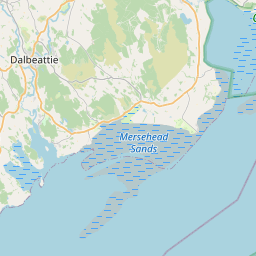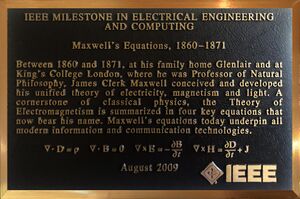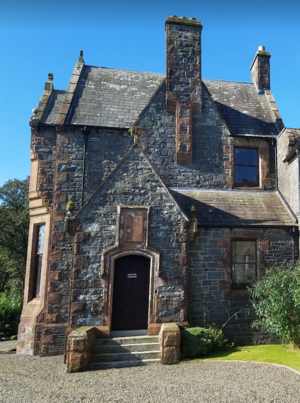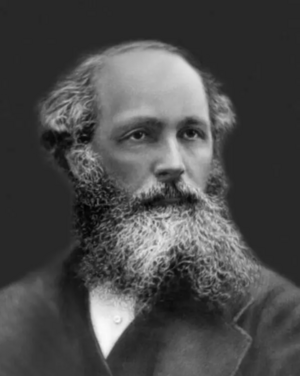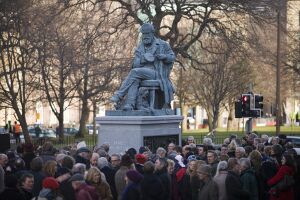Milestones:Maxwell's Equations, 1860-1871
- Date Dedicated
- 2009/08/13
- Dedication #
- 86
- Location
- London, England
- Glenlair, Scotland
- IEEE Regions
- 8
- IEEE sections
- United Kingdom and Ireland
- Achievement date range
- 1860-1871
Citation
Between 1860 and 1871, at his family home Glenlair and at King’s College London, where he was Professor of Natural Philosophy, James Clerk Maxwell conceived and developed his unified theory of electricity, magnetism and light. A cornerstone of classical physics, the Theory of Electromagnetism is summarized in four key equations that now bear his name. Maxwell’s equations today underpin all modern information and communication technologies.
Plaque Locations
- Site 1: King's College's Strand Campus, King’s Building, 2nd floor, just outside the Nash Lecture Theatre; The Strand, London UK WC2R 2LS (GPS: 51.511585, -0.116061). Enter the campus through Strand reception for public lectures, and during daytime hours on weekdays.
- Site 2: James Clerk Maxwell Foundation Museum, 14 India Street, Edinburgh, Scotland EH3 6EZ (GPS: 55.955345, -3.205786) (arrange an online or in-person visit at https://ClerkMaxwellFoundation.org) The plaque is mounted on a wall in the museum's entrance foyer, close to a duplicate Standardisation of the Ohm IEEE Milestone plaque.
- Site 3: Glenlair House, Knockvennie, Castle Douglas, Kirkcudbrightshire, Scotland (private estate; no public access)
Historical background
James Clerk Maxwell began his first serious work on electromagnetism when he was a Fellow at Cambridge University, 1854 – 1856. From 1860 – 1865 he was a Professor at King’s College London, during which time he did some key experiments at the College and at his residence in Kensington. He began to spend his summers at Glenlair, Scotland where he also conducted experiments. During his tenure at King’s College, he published his two most important papers on electromagnetic theory: “On Physical Lines of Force” (1861), which added a critical correction to Ampère's circuital law; and “A Dynamical Theory of the Electromagnetic Field” (1865), which proposed light as an electromagnetic wave. In both cases he pioneered the use of mathematics in describing the behavior of light. From 1865 – 1871, Maxwell lived full-time at Glenlair as an independent scholar, during which time he wrote his magnum opus, Treatise on Electricity and Magnetism (published in 1873), which summarized all of the known theory of electromagnetism, including his own contributions. We specify the dates 1860 – 1871 for the Milestone- this covers Maxwell’s time at King’s College London and subsequently Glenlair, during which time Maxwell published the two key papers on the theory of electromagnetism, and wrote the Treatise.
Maxwell deduced that light was an electromagnetic wave, thus revolutionizing the fields of electrical science and electrical engineering. He pioneered the use of calculus in electromagnetic science and independently derived three of the four modern equations that now bear his name. These are Gauss' Law, Gauss' Law for Magnetism, and Ampere’s Law with Maxwell’s correction, and appear in their original scalar form at equations (115), (56) and (112) in his 1861 paper On Physical Lines of Force. In this paper he also derived a full-time-derivative version of Faraday’s Law (at equations (54) and (77)), which is a more general version of the fourth modern Maxwell equation. Equation (77) additionally includes a term for the Lozentz Force, predating the work of Lorentz. The correction to Ampere’s Circuital Law introduced the electric displacement current, which ultimately enabled his derivation of the electromagnetic wave equation in his 1865 paper A Dynamical Theory of the Electromagnetic Field. In the 1873 Treatise on Electricity and Magnetism, Maxwell introduced a condensed, vector form of the equations in quaternion notation (Volume 2, chapter IX General Equations of the Electromagnetic Field). These included the vector fields E, B, D and H and vector potential A as are used today (albeit originally written in German Script).
It was Oliver Heaviside who subsequently introduced the fourth modern Maxwell equation as a partial-time-derivative version of Faraday’s Law, and recast the equations derived by Maxwell in their well-known vector calculus form, but he acknowledged that it was Maxwell who did the original work. Albert Einstein specifically acknowledged the importance of Maxwell in his development of special relativity. It was apparently Einstein who originally referred to them as “Maxwell’s Equations,” and this is the way they are known to the broader public.
Maxwell built on the earlier work of many giants, including Ampere, Gauss and Faraday, but he himself was a giant who revolutionized the field of electrical and optical physics, and laid the groundwork for electrical, radio and photonic engineering, with his experiments, theories and publications. The unification of the theories of electricity, magnetism and light, which comes directly from Maxwell’s equations, clearly sets Maxwell’s work apart from similar achievements of the time.
List of supporting documents and publications
James Clerk Maxwell. “On Physical Lines of Force,” (1861), 161ff.
James Clerk Maxwell. “A Dynamical Theory of the Electromagnetic Field,” Phil. Trans. Royal Soc. 155 (1865), p. 459ff.
James Clerk Maxwell. A Treatise on Electricity and Magnetism, Volume 2 (Oxford, U.K.: Clarendon Press, 1873): Chapter IX, "General Equations of the Electromagnetic Field."
George R. Steber, "The Discovery of Radio Waves" which notes the two Milestone dedication events that were held at King's College and at Glenlair.
James Clerk Maxwell Foundation document: Electromagnetic Theory
Dedication Ceremonies
Two Milestone dedication ceremonies were held in 2009: one at King's College's Strand Campus in London, and one at Glenlair House in southwestern Scotland.
Map
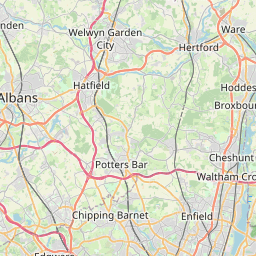












Map



